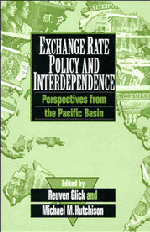Book contents
- Frontmatter
- Contents
- List of contributors
- Preface
- Exchange rate policy and interdependence
- 1 Overview
- I International financial market integration
- II Choice of exchange rate regimes
- 5 Exchange rate management: a partial review
- 6 Exchange rate policy and insulation from external shocks: the cases of Korea and Taiwan, 1970–1990
- 7 Trade price shocks and insulation: Australia's experience with floating rates
- 8 The role of the exchange rate in New Zealand monetary policy
- 9 Officially floating, implicitly targeted exchange rates: examples from the Pacific Basin
- III Intervention and sterilization policies
- IV Prospects for a yen bloc
- Index
9 - Officially floating, implicitly targeted exchange rates: examples from the Pacific Basin
Published online by Cambridge University Press: 04 May 2010
- Frontmatter
- Contents
- List of contributors
- Preface
- Exchange rate policy and interdependence
- 1 Overview
- I International financial market integration
- II Choice of exchange rate regimes
- 5 Exchange rate management: a partial review
- 6 Exchange rate policy and insulation from external shocks: the cases of Korea and Taiwan, 1970–1990
- 7 Trade price shocks and insulation: Australia's experience with floating rates
- 8 The role of the exchange rate in New Zealand monetary policy
- 9 Officially floating, implicitly targeted exchange rates: examples from the Pacific Basin
- III Intervention and sterilization policies
- IV Prospects for a yen bloc
- Index
Summary
Introduction
According to the International Monetary Fund (IMF), as of December 1991, only 29 of its 156 members had exchange rate arrangements that could be described as “independently floating.” Forty–two member countries had arrangements described as “managed floats,” “adjusted according to a set of indicators,” or “cooperative arrangements.” More than one–half of the IMF membership had either official pegs to a single currency or currency basket, or arrangements that were described as “flexibility limited vis–à–vis a single currency.” While the collapse of Bretton Woods meant the end of that particular fixed rate system, almost twenty years later a majority of countries still choose to impose some sort of constraint on the free movement of the value of their currencies.
Even those countries that claim to adhere to an independently floating exchange rate regime typically manage their exchange rates to some extent. Most central banks have policies of intervening to stabilize the prices of their currencies when the foreign exchange markets become “disorderly,” as, for example, after the U.S. stock market crash in October 1987. In addition, some central banks with an official policy of freely floating rates also have implicit exchange rate targets that affect the conduct of monetary policy. Sometimes these targets are part of international agreements, such as the Plaza Agreement of 1985 and the Louvre Accord of 1987. Both agreements stressed that “exchange rates should better reflect fundamental economic conditions,” and the Louvre Accord actually proposed specific targets for the dollar, mark, and yen exchange rates.
- Type
- Chapter
- Information
- Exchange Rate Policy and InterdependencePerspectives from the Pacific Basin, pp. 198 - 222Publisher: Cambridge University PressPrint publication year: 1994
- 2
- Cited by



